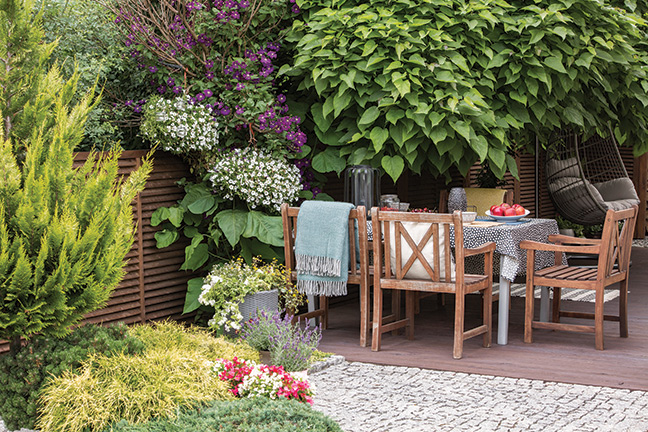BY ANNIE HUSTON, BIRDSALL & CO.
A gardener with hands in the soil and hopes of growing plants is a gardener, no matter the size and scope of the endeavor. If addressing the design and plantings of your landscape is overwhelming in terms of switching it to a more environmentally friendly outdoors, start small and congratulate yourself for your effort. There are some low hanging fruit that have an impact on your garden/micro-climate while you work on a master plan to retrograde your entire landscape.
Plant a tree – even a little bitty tree will grow big someday and provide natural shade for your home. The Arbor Day Foundation tells us that “planting a tree is one of the easiest and most powerful things you can do to have a positive impact on the environment; it will clean the air, prevent rainwater runoff, help save energy and will make you happy every day as you see it grow and mature.” This is a reminder that Denver Digs Trees will have their Annual Arbor Day Tree Sale on April 25, 2020. Pick from fruiting, flowering or shade trees and while enjoying a wonderful community day around the betterment of our city.
Water better
If our plants could talk, they would tell us not to water when the sun is out, and instead wait until the air is cool. You’ll also save water by limiting evaporation. Even better is to take your coffee/tea or your cocktail of choice and to take the time to water at the base of plants rather than overhead. Bend, lift the leaves, don’t spill the drink and take the time to do it right.
Create a wildlife habitat
The National Wildlife Federation encourages home gardeners to become a Certified Wildlife Habitat. Follow these steps, and you will receive a sign you can proudly display in your yard, therefore encouraging your neighbors to emulate your efforts.
As per the National Wildlife Federation:
Food: Native plants provide food eaten by a variety of wildlife. Feeders can supplement natural food sources.
Water: All animals need water to survive, and some need it for bathing or breeding as well.
Cover: Wildlife need places to take shelter from bad weather and places to hide from predators or hunt for prey.
Places to raise young: Wildlife need resources to reproduce, and to protect and nourish their young
Sustainable practices: Maintain your yard or garden in natural ways to ensure soil. Air, and water stay healthy and clean.
Practical translation – try and plant these beauties that Matt Edrich from Fort Collins Nursery recommends:
Bearberry (kinnikinnick) is a groundcover shrub that can be found in dry shaded areas all over Colorado. It is native! Many animals rely on bearberry: caterpillars, butterflies, and hummingbirds feed on its nectar, the berries themselves are a staple for animals including robins, thrushes, and waxwings.
Colorado Blue Columbine grows in light shade and its nectar feeds crucial pollinators (bees, butterflies, moths) and hummingbirds.
Serviceberry is a large shrub for hot and dry conditions and its fruits are food for both resident and migrant birds.
Mountain Snowberry is a shrub that tolerates full sun to nearly full shade. Snowberries attract songbirds!
Woods Rose is a native wild rose bearing pink single-petal blossoms in late spring and early summer that bees love.
Supplement with bird feeders that double as garden art thanks to their beautiful colors and designs. If squirrels are a problem, it is easy to choose a squirrel-proof bird feeder that will let your birds eat in peace.
Water
Bird baths are ubiquitous in gardens and they are the perfect drinking fountain/bathtub for birds. Bird bath fountains provide the same benefits in smaller spaces where a larger scale fountain is too big a footprint. Lots of us have watched the video of the hummingbirds having a party in and around a fountain. Self-contained fountains have the advantage of being architecturally beautiful in the garden. Since they last for decades, they are worth the initial investment, both financial and environmental.
Water gardens are straightforward if you have a pond: simply drop aquatic plants and watch them flourish, especially if you have fish in the water. Otherwise, small scale water gardens can be built in containers, using water hyacinths, water lettuce, water wisteria, water lilies and acorus, to name a few.
What to do if your outdoor space is limited or you cannot commit to a full garden?
All of the above recommendations can be scaled down to a patio, a terrace of large balcony. Gather containers and plant them with anything from a tree, shrub, perennials or annuals. Make sure the containers are large enough and plant away. Here are a few suggestions:
Newport Plum, Japanese Maple, Nandina, Little Gem Norway Spruce, Blue Shag Dwarf White Pine, Hibiscus, Mandevilla, Container roses, Arrowhood Viburnum, Coreopsis, Rudbeckias, and Coneflower. Include some annuals for a burst of color but don’t stop there. Add edibles for the humans (hopefully, just humans!) and plant vegetables for your own pleasure and table: tomatoes, cucumber, eggplant, bok choy and all the herbs your cooking skills require. Container gardening is not as back breaking as in-ground planting and you do not have to contend with weeds. A small bird bath or fountain will complete your miniature garden and will give you so much pleasure, while doing your part for our animal friends.

